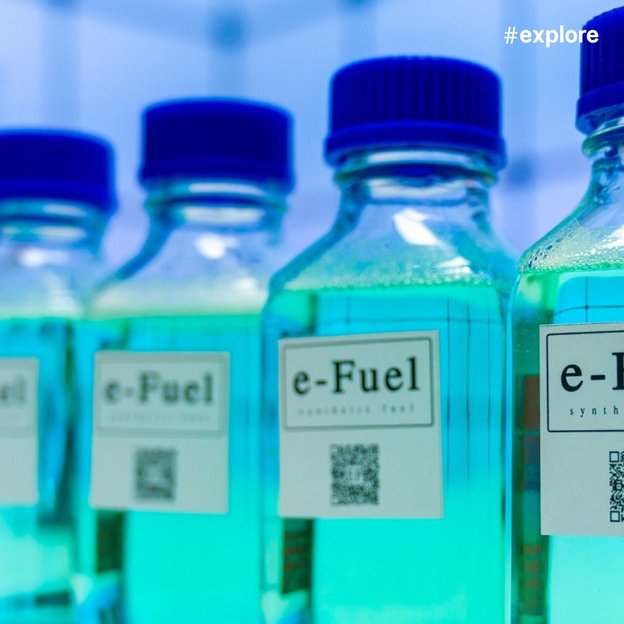Klimaneutraler Verkehr
Was sind E-Fuels?
Sind Stromkraftstoffe eine klimafreundliche und bezahlbare Alternative?

Klimaneutraler Verkehr
Sind Stromkraftstoffe eine klimafreundliche und bezahlbare Alternative?

23. November 2023
Ab 2035 dürfen in der EU nur noch abgasfreie Pkw und leichte Nutzfahrzeuge neu zugelassen werden. Mit einer Ausnahme: Neuwagen mit Verbrennungsmotor erhalten eine Zulassung, wenn sie ausschließlich mit synthetischen und zu 100 Prozent CO2-neutralen Treibstoffen unterwegs sind. Während einige die sogenannten E-Fuels für eine ideale Lösung halten, sehen andere den Einsatz im Auto kritisch. Wir klären die wichtigsten Fragen rund um die synthetischen Kraftstoffe.
Was sind E-Fuels?
E-Fuels ist die Abkürzung für Elektrokraftstoffe. Sie werden mithilfe von Strom aus Wasser und Kohlenstoffdioxid (CO2) gewonnen und haben nahezu dieselben Eigenschaften wie fossiles Benzin oder Diesel. Daher können sie auch ohne Umrüstung in normalen Verbrennungsmotoren eingesetzt werden, sofern die Hersteller die Nutzung des alternativen Kraftstoffes für das jeweilige Fahrzeug freigegeben haben.
Wie werden die grünen Stromkraftstoffe hergestellt?
Zunächst wird in der Elektrolyse mit Strom aus erneuerbaren Energien Wasser in Sauerstoff und Wasserstoff aufgespalten. Der Wasserstoff wird dann im sogenannten Fischer-Tropsch-Verfahren mit CO2 zu einem synthetischen Rohöl verarbeitet und anschließend in unterschiedliche Kraftstoffe raffiniert. Dabei entstehen immer sowohl E-Benzin und E-Diesel als auch E-Kerosin. „Für alle drei Endprodukte braucht es Abnehmer:innen. Es wäre also nicht wirtschaftlich, E-Fuels etwa nur in der Luftfahrt einzusetzen“, sagt Manuel Hagemann, Experte für alternative Antriebe bei TÜV NORD.
Wie klima- und umweltfreundlich sind E-Fuels?
Wie bei konventionellem Benzin oder Diesel werden bei der Verbrennung von E-Fuels Stickoxide, Feinstaub und CO2 freigesetzt. Dieses CO2 ist aber unter zwei Voraussetzungen klimaneutral:
Dadurch geht bei der Verbrennung der synthetischen Kraftstoffe kein zusätzliches Kohlendioxid in die Luft, und die Emissionsbilanz ist insgesamt CO2-neutral. Im Gegensatz zu Batterie - oder Brennstoffzellenautos kann die Stickoxid- und Feinstaubbelastung der Städte durch den Einsatz von E-Fuels jedoch nicht gesenkt werden. „Diese Emissionen lassen sich aber durch vorhandene Abgasreinigungssysteme signifikant reduzieren“, sagt Helge Schmidt, Experte für Abgasemissionen bei TÜV NORD. „Da sich die Zusammensetzung der E-Fuels bei der Herstellung beeinflussen lässt, versucht man auch auf diesem Wege, die Emissionen von Schadstoffen zu minimieren.“
What about the energy balance of e-fuels?
The energy balance of synthetic fuels is the most important argument against their widespread use in road transport. This is because their production requires an enormous amount of energy, and combustion engines are incomparably less efficient than electric motors.
A car fuelled with e-fuels therefore needs a good five times as much energy per kilometre as an electric car. And green electricity will not be available in abundance for the foreseeable future.
What role can e-fuels play in road traffic?
In aviation and shipping, batteries are not a viable alternative in the long term – especially for long distances. Therefore, these industries aim to make their operations less CO2-intensive in the future by using hydrogen and e-fuels. In the automotive sector, however, the electric motor is considered the best and most efficient solution to meet climate goals. Yet, vehicles with internal combustion engines will not disappear from the roads anytime soon, according to Helge Schmidt from TÜV NORD. Even if conventional combustion engines are no longer sold after 2035, it is estimated that it will take around 15 years for the entire vehicle fleet in the EU to be renewed. "The use of synthetic fuels can be important during this transition phase to reduce CO2 emissions in road traffic on a balance sheet basis," says expert Schmidt.
How much does the synthetic fuel cost?
If they are going to be viable for motorists, e-fuels must above all be affordable. At present, however, they don’t offer an alternative to fossil fuels in price terms, also because they have so far only been produced in very small quantities. According to estimates, when the industrial production of e-fuels starts, production costs of two to three euros per litre might initially be incurred. This would make them three to five times more expensive than a litre of conventional petrol, which was traded for around 60 cents on wholesale markets in October 2023. However, the price of e-fuels is likely to fall if production continues to increase and manufacturing processes are optimised. Not only that, but the mineral oil tax would be a way for policymakers to make synthetic fuels competitive with fossil fuels.

When will we be able to pump e-fuels at petrol stations?
Like conventional petrol or diesel, it will be possible to distribute e-fuels via the existing network of filling stations. So the infrastructure is already in place. So far, however, the synthetic fuels have only been produced in a few pilot plants – for example, in a pilot plant in Chile, where there’s lots of wind, in which Porsche is also involved. Karlsruhe-based Ineratec plans to commission the first large-scale industrial production plant for the production of e-kerosene in Germany in Frankfurt am Main in 2024.
According to an analysis by the Potsdam Institute for Climate Impact Research, around 60 new e-fuel projects have been announced worldwide for the period until 2035. Of these, however, only one percent have already had their financing definitively sorted out. Even if all 60 plants are actually built, together they would cover just ten percent of Germany’s demand. And that’s only where e-fuels are indispensable, i.e. in aviation, shipping and the chemical industry. To boost investment in production facilities for e-fuels, the EU wants to give companies security for their future planning with a fixed quota system.
EU quota for e-fuels
EU requirements state that 29 percent of the energy consumed in the transport sector will have to come from renewable sources by 2030.
How will cars be able to drive on e-fuels only from 2035?
What this new vehicle category will look like is currently still to be resolved. “Among other things, it’ll need to be ensured that newly registered vehicles can actually be refuelled exclusively with e-fuels,” says Helge Schmidt. “One possibility would be to deploy smart fuel pumps that communicate with the vehicle,” says the emissions expert. Special fuel nozzles that only fit e-fuels vehicles are also being discussed. However, the associated statutory regulations are only expected in future years.
Dies ist ein Artikel von #explore. #explore ist eine digitale Entdeckungsreise in eine Welt, die sich in rasantem Tempo wandelt. Die zunehmende Vernetzung, innovative Technologien und die alles umfassende Digitalisierung schaffen Neues und stellen Gewohntes auf den Kopf. Doch das birgt auch Gefahren und Risiken: #explore zeigt einen sicheren Weg durch die vernetzte Welt.